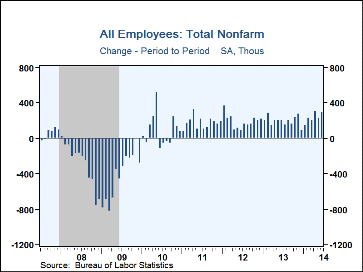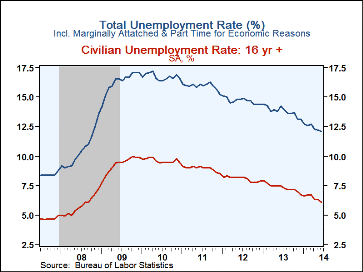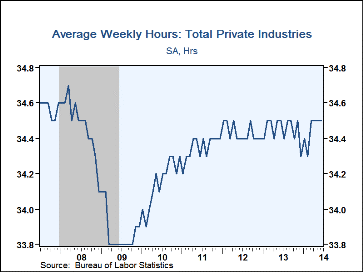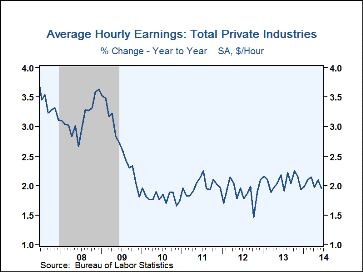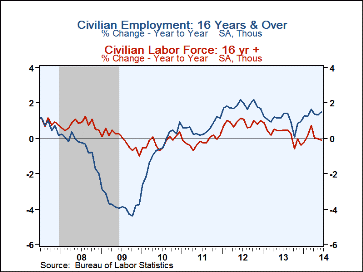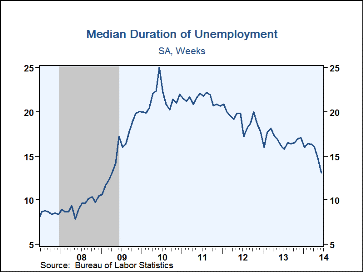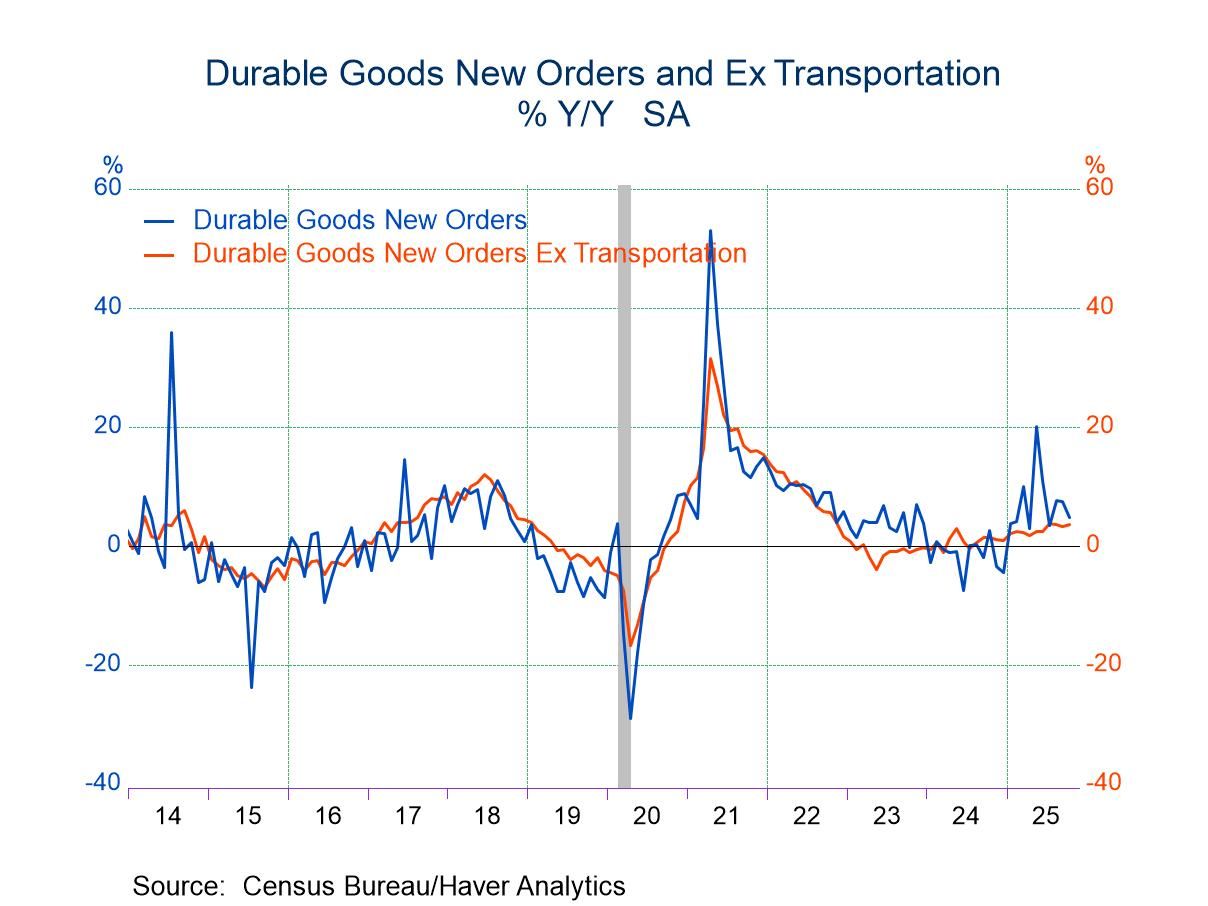 Global| Jul 03 2014
Global| Jul 03 2014U.S. Payroll Employment Growth Improves; Jobless Rate Falls Further
by:Tom Moeller
|in:Economy in Brief
Summary
The labor market is on a firmer footing. Nonfarm payrolls increased 288,000 during June following upwardly-revised gains of 224,000 and 304,000 during the prior two months. The increase easily outpaced expectations for a 215,000 rise [...]
The labor market is on a firmer footing. Nonfarm payrolls increased 288,000 during June following upwardly-revised gains of 224,000 and 304,000 during the prior two months. The increase easily outpaced expectations for a 215,000 rise in the Action Economics Forecast Survey. The unemployment rate moved lower to 6.1% versus an expected 6.3%. The overall unemployment rate, including marginally attached workers and those employed part-time for economic reasons, slipped to 12.1%.
From the payroll employment survey, nonfarm jobs grew 288,000 during June. That raised the average increase during the last three months to 272,000, its strongest since March 2012. Factory sector payrolls grew an improved 16,000 but construction sector payroll gained a lessened 6,000. It was in the service sector where the rate of labor market improvement picked up steam. Nonfarm private service sector jobs grew 236,000 (2.2% y/y) and the three-month gain improved to 222,000, both the strongest increases in two years. Professional & business services jobs advanced 67,000 (3.5% y/y) including a 10,100 rise (8.1% y/y) in temporary employment, its weakest monthly gain in the last five. Retail trade hiring advanced 40,200 (2.1% y/y) while leisure & hospitality jobs grew 39,000 (2.8% y/y). Health care employment rose a moderate 33,700 (1.8% y/y) and wholesale trade hiring rose 15,100 (2.4% y/y). Jobs in transportation & warehousing rose 16,600 (3.1% y/y) and information sector employment gained 9,000 (-1.0% y/y). Government sector employment showed great improvement. The 26,000 job gain (0.3% y/y) pulled the average three-month advance to 17,000 which equaled its best since 2010. Local government hiring grew 22,000 (0.6% y/y) and state government employment rose 2,000 (0.6% y/y). Federal government jobs improved 2,000 (-2.0% y/y) but that only offset a May decline.
The length of the average workweek held steady at 34.5 hours for the fourth straight week. The factory sector workweek remained at 41.1 hours, the longest of the economic recovery. The construction workweek lengthened to 39.0 hours and private services held at 33.3 hours for the fourth straight month. For all of the second quarter, aggregate hours worked (employment times hours) rose at a 3.8% annual rate versus Q1, the strongest gain in three years.
Average hourly earnings improved 0.2% (2.0% y/y). Factory sector earnings gained 0.4% (1.8% y/y) while information sector earnings improved 0.4% as well (3.1% y/y). Financial sector earnings grew 0.7% (2.2% y/y) and professional & business services earnings rose 0.3% (2.4% y/y). Earnings in the education sector were unchanged (0.8% y/y).
From the household employment survey, the unemployment rate fell to 6.1%, its lowest level since September 2008. The decline reflected a 407,000 gain (1.5% y/y) in employment which easily outpaced the 81,000 rise (-0.1% y/y) in the labor force. That rise left the labor force participation rate of 62.8% stable at its lowest level since early-1978. The number of potential workers not in the labor force grew 2.7%, about the rate of growth since 2009. Twenty five percent of workers had been unemployed for more than 52 weeks.
The median duration of unemployment dropped to 13.1 weeks. That's versus a high of 25.0 weeks in June of 2010. The average length of joblessness fell to 33.5 week, its lowest level since September 2010.
The unemployment rate for those without a high school diploma remained high at 9.1% while high school graduates realized a greatly lessened 5.8% unemployment rate. Those with some college but no diploma were 5.0% unemployed and college graduates realized 3.3% unemployment.
The figures referenced above are available in Haver's USECON database. Additional detail can be found in the LABOR and in the EMPL databases. The expectation figures are from Action Economics and are in the AS1REPNA database.
| Employment: (M/M Chg., 000s) | Jun | May | Apr | Y/Y | 2013 | 2012 | 2011 |
|---|---|---|---|---|---|---|---|
| Payroll Employment | 288 | 224 | 304 | 1.8% | 1.7% | 1.7% | 1.2% |
| Previous | -- | 217 | 282 | -- | -- | -- | -- |
| Manufacturing | 16 | 11 | 9 | 1.1 | 0.7 | 1.7 | 1.7 |
| Construction | 6 | 9 | 36 | 3.2 | 3.3 | 2.1 | 0.2 |
| Private Service Producing | 236 | 202 | 228 | 2.2 | 2.2 | 2.2 | 1.9 |
| Government | 26 | 0 | 26 | 0.3 | -0.3 | -0.8 | -1.8 |
| Average Weekly Hours - Private Sector | 34.5 | 34.5 | 34.5 | 34.5 (Jun'13) |
34.5 | 34.4 | 34.3 |
| Average Private Sector Hourly Earnings (%) | 0.2 | 0.2 | 0.0 | 2.0 | 2.1 | 1.9 | 2.0 |
| Unemployment Rate (%) | 6.1 | 6.3 | 6.3 | 7.5 (Jun'13) |
7.4 | 8.1 | 8.9 |
Tom Moeller
AuthorMore in Author Profile »Prior to joining Haver Analytics in 2000, Mr. Moeller worked as the Economist at Chancellor Capital Management from 1985 to 1999. There, he developed comprehensive economic forecasts and interpreted economic data for equity and fixed income portfolio managers. Also at Chancellor, Mr. Moeller worked as an equity analyst and was responsible for researching and rating companies in the economically sensitive automobile and housing industries for investment in Chancellor’s equity portfolio. Prior to joining Chancellor, Mr. Moeller was an Economist at Citibank from 1979 to 1984. He also analyzed pricing behavior in the metals industry for the Council on Wage and Price Stability in Washington, D.C. In 1999, Mr. Moeller received the award for most accurate forecast from the Forecasters' Club of New York. From 1990 to 1992 he was President of the New York Association for Business Economists. Mr. Moeller earned an M.B.A. in Finance from Fordham University, where he graduated in 1987. He holds a Bachelor of Arts in Economics from George Washington University.


